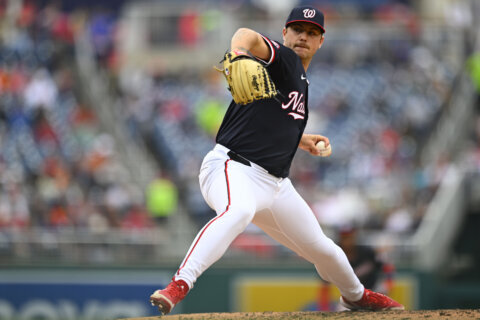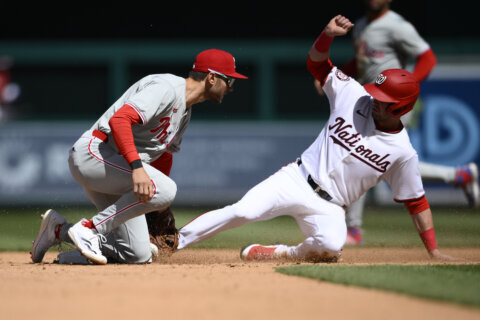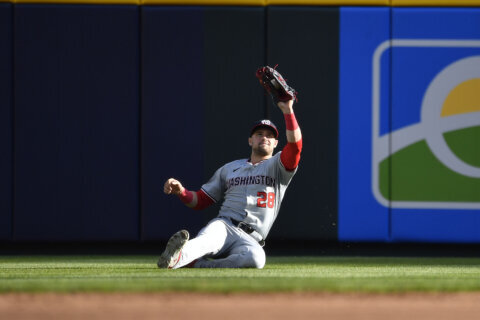WASHINGTON — Coming into the offseason, the Washington Nationals had a number of priorities to address. Hire a new manager: check (albeit, not uneventfully). Bolster the bullpen: check (although the biggest questions still remain). Reinforce the lineup: check?
Nationals Executive VP & General Manager Mike Rizzo and company have long spoken about playing for today with an eye on tomorrow, trying to manage success in both the present and the future. But baseball is a game of competitive windows. Washington’s prime window passed this season, with Ian Desmond, Doug Fister, Denard Span and Jordan Zimmermann departing. There is another three-year window still open, the remaining amount of time that the team has Bryce Harper under contract. It seems like a reasonable course of action to structure deals to take advantage of that window.
We’ll get to the Daniel Murphy signing in a moment, but we’re only six weeks from pitchers and catchers reporting to Spring Training and both Jonathan Papelbon and Drew Storen are still under contract. As last summer proved, this is an untenable situation moving forward, and at least one (Papelbon) if not both players and the Nationals will be better served by finding them new homes before mid-February.
Reports have come out this week that the Nationals are still trying to trade Storen, but have so far done nothing with Papelbon, other than shield him from the fans at WinterFest, thanks to a conveniently pre-planned international trip. Papelbon’s extensive no-trade list may make him nearly impossible to deal, but the Nationals cannot afford to have him and the day-to-day distraction he brings in the clubhouse after what happened so publicly with Harper last year.
And while the trade for Trevor Gott and signings of Shawn Kelley and Yusmeiro Petit answer some of the middle inning questions, the Nats abandoned their attempts at acquiring Aroldis Chapman, and have not been reported to be in the mix for other back-of-the bullpen arms. The question of who will pitch the eighth and ninth innings is still very much unanswered.
Meanwhile, Washington lost out on their pursuit of Ben Zobrist, the player who made the most sense to fortify the infield, provide a left-handed option at the plate and potentially help spell Werth in left field in case of injury. Later, they had a trade in place in principle to acquire Reds second baseman Brandon Phillips, but it fell through as the veteran would not waive his no-trade clause to come to Washington. That led to the team’s pursuit, and eventual signing, of Murphy.
Murphy’s OPS+ last season — 113 — was identical to the recently traded Yunel Escobar’s. And while he’s a couple years younger, there’s no reason to believe that he will improve upon his career averages of nine home runs (Escobar’s exact 2015 total) and a .331 on-base percentage (below Escobar’s .375 mark last year and .350 mark for his career) as he enters his age 31 season. His left-handed bat provides more balance for the lineup, yes, but it’s difficult to see him as an upgrade.
The aforementioned three-year window is the context through which the Murphy deal makes the most sense. It shores up the middle infield for the near-term, allowing Anthony Rendon to (finally) move back to third base, where he is more valuable. But is the team really ready to head to Viera with Michael Taylor and Jayson Werth as two-thirds of its starting outfield?
Werth was better down the stretch last season, but slashed just .226/.305/.426 after his return from the disabled list in late July. Those numbers — not even counting his horrid start — would rate as his worst season since 2011, and arguably his worst overall as he heads into his age 37 season. Taylor, meanwhile, has not yet made the adjustment to hitting big league pitching consistently, batting just .229 with a .282 on-base percentage, wiping out much of the positives of his 14 homers and 16 steals.
After losing out — again — on prized free agent Jason Heyward, the Nats seem to be in the mix for another lesser option in the outfield. A trade for the Rockies’ Carlos Gonzalez would answer those questions on one level, but would raise a slew of others. Gonzalez hit a career-best 40 home runs last season, but that was the first time he has cleared 150 games in his career, due to a litany of injuries. He also would come with $37 million in guaranteed contract money over the next two seasons, and would command an impressive prospect load in return. If the Nationals weren’t willing to trade prospects for players when they really needed them last summer, why give them up now, when a player could be had on the free agent market for money (and potentially a compensatory draft pick) alone?
The club had just over $102 million in salary commitments before the Murphy deal, and without counting the arbitration figures for Danny Espinosa, Anthony Rendon, Storen, Stephen Strasburg and Wilson Ramos, which ought to shake out to roughly another $30 million. That still leaves the club about $30 million shy of their Opening Day payroll last season. And considering the payroll has risen every year since 2007 — and more than doubled from 2011 to 2015 — there is reason to believe there is money to be spent.
The three remaining big bats on the open market are Yoenis Cespedes, Chris Davis and Justin Upton. Davis makes little sense, as a first baseman with no positional versatility playing at a spot on the diamond where Washington already has a high-priced vet in Ryan Zimmerman. Cespedes’ ability to play center would provide the club with the outfield flexibility that they missed out on in Heyward, but his age and the number of years he is seeking may be prohibitive.
Upton seems the likeliest option of those three, considering his age (still just 28), and his ties to Rizzo, who drafted him with the first overall pick when he was with the Diamondbacks in 2005. Upton has provided consistently good-to-great offensive production throughout his nine-year career, averaging 27 home runs and a .262/.344/.470 line the past three seasons. While he doesn’t give the team another option in center, he can play both left and right field, allowing for some measure of versatility.
Of course, Rizzo also has ties to Gerardo Parra from Arizona, and the team has been rumored to have been in touch with him. Parra would provide a versatile outfielder at a lower price, albeit a less productive one than Upton or Cespedes. He has slashed .277/.326/.404, averaging eight homers and 10 steals per season in his career. That makes him a solid fourth outfielder option, but doesn’t really address the leadoff spot or provide a high-quality starter. He is also a career -3 defensive runs saved (DRS) in center (including a -7 over 354 innings the past two seasons). Taylor, for comparison, was -2 DRS last year in center last year, but +5 overall thanks to better numbers in left.
A more sensible option might be available in Dexter Fowler, a switch-hitter who sports a career .363 on-base percentage and has averaged nine triples, nine homers, and 16 steals a year since 2009. Fowler has been a center fielder his entire career, and though his defensive numbers aren’t stellar, he checks the rest of the boxes and was an instrumental part of the Cubs’ success in 2015.
Regardless of which way they decide to go, it is clear that there are still holes to be filled and personnel moves to be sorted out. Rizzo has been known for his late offseason moves — see: Edwin Jackson (Feb. 2) in 2012, Rafael Soriano (Jan. 17) in 2013, and Max Scherzer (Jan. 21) in 2015. If the Nats are going to reestablish themselves as front-runners in the NL East, he’ll need to pull off at least one more.







